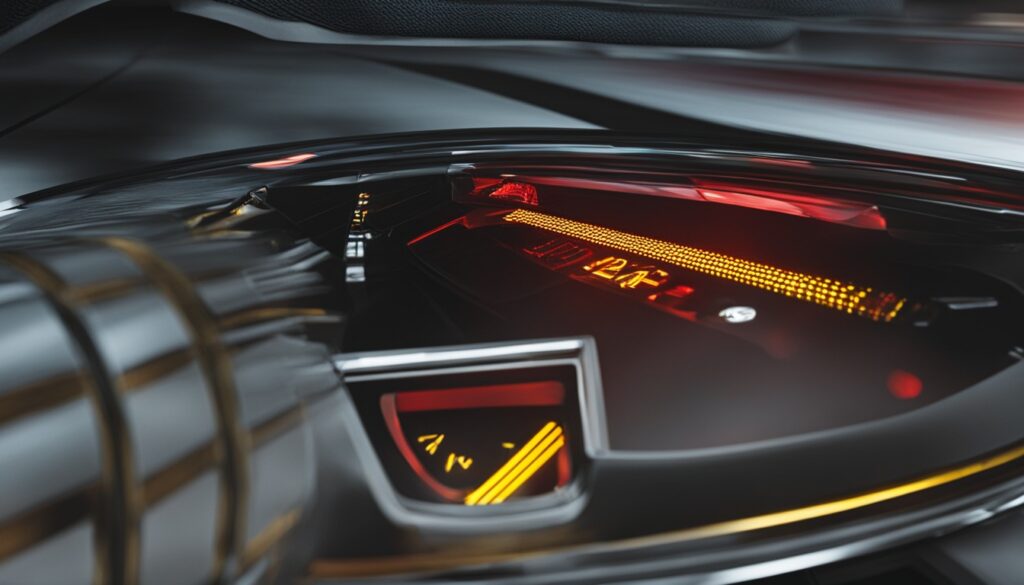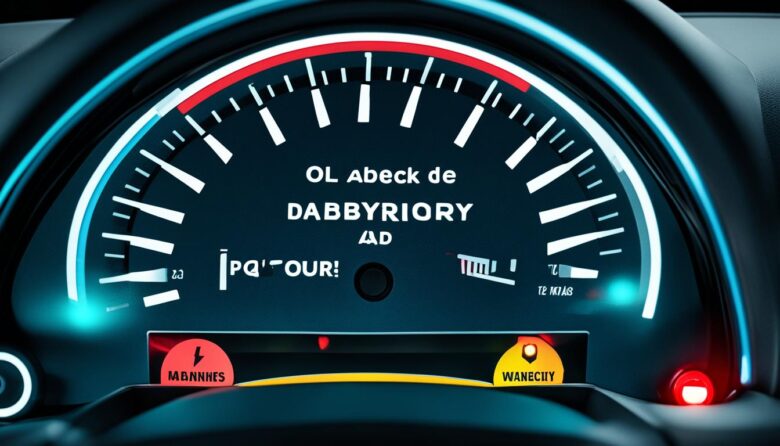Have you ever felt a surge of panic when a mysterious light suddenly flashes on your car’s dashboard? You’re not alone. With nearly 480 different symbols and indicators used across all makes and models, it’s no wonder many of us feel overwhelmed by these tiny illuminated messengers1. Let’s demystify these crucial communication tools and explore why they’re so vital for our safety on the road.
Dashboard warning lights are our vehicle’s way of speaking to us. They briefly light up during startup, assuring us that all systems are functioning correctly. But when they stay on or flash unexpectedly, it’s time to pay attention. Ignoring these signals can lead to costly repairs or even dangerous situations.
Color-coding helps us prioritize these warnings. Red lights demand immediate action, signaling potential safety issues or serious problems1. Orange or yellow lights typically indicate upcoming maintenance needs or non-critical issues1. Green or blue lights are usually informational, confirming that certain systems are active12.
Understanding these indicators is crucial, especially in areas like Chattanooga, where unpredictable traffic and challenging mountain terrain can add extra stress to your vehicle3. By learning to decode these lights, we can stay ahead of potential problems and ensure our journeys remain safe and smooth.
Key Takeaways
- Dashboard lights use a color-coded system to indicate urgency
- Red lights require immediate attention for safety issues
- Yellow or orange lights suggest upcoming maintenance needs
- Green or blue lights are typically informational
- Understanding warning lights is crucial for vehicle safety and maintenance
- Ignoring warning lights can lead to costly repairs or dangerous situations
The Importance of Car Warning Lights
Car warning lights are like a secret language from your vehicle. They alert us to problems early, helping us avoid bigger issues later. Let’s explore why these lights are so crucial.
How warning lights communicate vehicle issues
Warning lights use a secret code to talk to us. They light up to signal different problems. Red lights tell us to stop and fix the issue right away. Yellow lights warn us to check things soon. Green or blue lights just share extra info4.
The check engine light can be confusing. It could mean anything from a loose gas cap to a serious engine problem5. If it blinks while driving, it’s urgent. It might mean your engine is misfiring, which could cause big damage if ignored5.
Brief history of dashboard indicators
Dashboard lights have been around since 1933 on the Hudson Super Six. They’ve evolved over time. In 1996, the U.S. made it mandatory for new cars and light trucks to have an On Board Diagnostic system for emissions5.
The role of warning lights in vehicle safety
Warning lights are key to our safety on the road. They act as an early warning system for our cars. By alerting us to problems early, they prevent costly repairs and keep us safe while driving4.
The oil pressure warning light is very important. Ignoring it could lead to major engine damage5. The coolant temperature gauge warns us if our engine is overheating. We must stop driving to avoid serious issues5.
Understanding these lights is vital for maintaining our cars and driving safely. When a light comes on, don’t panic. Check your car’s manual, and get help right away for red lights. For yellow lights, plan to get it checked soon. By paying attention to these lights, we can keep our cars running well and stay safe.
| Warning Light | Color | Meaning | Action |
|---|---|---|---|
| Check Engine | Yellow | Various engine issues | Get checked soon |
| Oil Pressure | Red | Low oil pressure | Stop immediately |
| Coolant Temperature | Red | Engine overheating | Pull over safely |
| Brake System | Red | Brake issue | Check brakes ASAP |
Car’s Warning Lights: A Comprehensive Guide
Modern cars have many warning lights to keep drivers updated on their car’s status. These lights use colors like traffic lights, with red meaning stop now, amber meaning act fast, and green meaning everything’s okay.
A car dashboard usually has 32 warning symbols, with 26% for safety and 12% for lights6. It’s important to know these symbols to keep your car running well and stay safe.
- Brake system alert: This red light means there’s a problem with your brakes, like low brake fluid or worn-out brake pads.
- Battery charge indicator: This light turns on when there’s an issue with charging your car or the alternator.
- Tire pressure monitor: This light warns you if your tire pressure is too low, which can make driving dangerous and wear out your tires faster.
Warning lights like the check engine light, brake warning light, and oil change reminder are seen often6. If you ignore these, you could face big problems. For example, ignoring an engine temperature warning can damage your engine badly, affecting parts like pistons, head gaskets, or the engine block itself7.
Regular car care helps avoid many warning lights. For instance, changing your oil every 3,000-5,000 miles for regular oil or 5,000-7,000 miles for synthetic oil can stop oil pressure issues7. Also, checking your tire pressure every month with a gauge can stop tire warnings and make driving safer.
| Warning Light | Color | Possible Causes | Recommended Action |
|---|---|---|---|
| Brake System Alert | Red | Low brake fluid, worn brake pads | Check brake fluid, inspect brake pads |
| Battery Charge Indicator | Red | Alternator issues, loose cables | Check battery connections, alternator |
| Tire Pressure Monitor | Amber | Low tire pressure | Check and adjust tire pressure |
| Check Engine Light | Amber | Various engine issues | Scan for diagnostic codes |
Learning about these warning lights and acting fast keeps our cars running well and our trips safe. If you’re unsure, always check your car’s manual or talk to a mechanic.
Decoding Red Warning Lights
Red warning lights on your dashboard need your immediate focus. They signal serious issues that could affect your safety or cause expensive repairs if ignored. Let’s explore some key red warnings you might see.
Brake System Warnings
A brake system alert is very serious. It might mean your brake pads are worn out, the fluid is low, or the anti-lock braking system (ABS) is faulty. If you see this light, check your brake fluid and get your system checked quickly. Bad brakes are a big risk for you and others on the road8.
Engine Oil Pressure Alerts
The oil pressure warning light is very important but often misunderstood. A surprising 73% of Americans don’t know its meaning9. It lights up when oil levels are too low or the oil system is broken. If you ignore this, your engine could suffer severe damage or fail. If you see this light, stop driving and check your oil levels right away.
Battery and Charging System Indicators
A battery charge indicator light means there’s a problem with your vehicle’s electrical system. This could be a battery, alternator, or electrical component issue. If it lights up while driving, you might see dimming headlights or flickering electronics10. It’s smart to get your car checked quickly to avoid being stuck with a dead battery.
Knowing what these red warning lights mean is key to keeping your car running well and staying safe on the road. Don’t ignore them – they’re your car’s way of telling you there’s a problem.
Understanding Amber/Orange Warning Lights
Amber or orange warning lights on your dashboard warn you of potential issues. They tell you to check systems like ABS, traction control, or suspension soon. Let’s look at what these lights mean and how to handle them.
The check engine lamp is a common amber warning you might see. It can mean many things, from small to big problems. It’s important to pay attention to this light because it could be about your emissions system or engine parts11.
Here’s a quick guide to some amber warning lights you might see:
- ABS (Anti-lock Braking System)
- Traction Control
- Adaptive Suspension
- Air Suspension
- Low Fuel Level
Amber lights don’t need immediate action like red lights do, but you should check them quickly. Ignoring them could lead to bigger problems later. For example, a Diesel Particulate Filter (DPF) warning light on can cause big issues12.
Some amber lights just mean a system is on, like cruise control or child safety locks. Knowing what these lights mean helps us take care of our cars and prevent bigger problems. If you’re not sure about a light, look in your car’s manual or talk to a mechanic.
The check engine light steady means you need to fix a problem at your next service. A flashing light means you need to take care of it right away13. By understanding these lights, we can keep our cars running well and safely.
The Check Engine Light: What It Means and What to Do
The check engine light is a warning that makes us nervous. It tells us something’s wrong with our car. Let’s explore what it means and how to handle it.
Common causes of a check engine light
A check engine light can mean many things, from small to big problems. Often, it’s just a loose gas cap, which is simple to fix. Other times, it could be issues with the catalytic converter, spark plugs, ignition coils, oxygen sensors, or a damaged mass airflow sensor. Sometimes, even bad gas can turn on the light14.
Immediate actions to take
Don’t freak out when the check engine light turns on. First, see if it’s steady or flashing. A steady light means it’s not as serious, but flashing means you should act fast to avoid engine damage15. If flashing, slow down and get to a mechanic right away.
For a steady light, try tightening your gas cap first. If it doesn’t go away, you’ll need a pro to check it out. Remember, ignoring it can lead to bigger problems and might fail a car inspection14.
The importance of diagnostic scans
Getting a diagnostic scan is key to finding out what’s wrong. It reads error codes from your car’s computer, making it easier for mechanics to fix the issue. You can get free scans at auto parts stores or buy an OBD-II scanner for home use.
Understanding the check engine light can save us time, money, and worry. By fixing problems fast, we keep our cars running well and safely for a long time.
Tire Pressure Monitoring System (TPMS) Warnings

The tire pressure monitor system is a key safety feature in modern cars. It warns drivers if tire pressure is not right, helping prevent accidents and keep the car running well16.
TPMS warnings show up as a tire icon on your dashboard. This light turns on if air pressure goes down by 10% or more16. Remember, tires lose air naturally over time, and this loss increases with colder weather16.
When you see the TPMS warning, check all tires, including the spare. Underinflated tires can make them slow to respond, use more fuel, and get too hot17. Overinflated tires can lead to poor traction and wear out faster17.
Some cars show real-time pressure for each tire. If the light doesn’t turn off after you inflate, look at your car’s manual for how to reset it or replace a bad sensor16.
| TPMS Light Behavior | Meaning | Action Required |
|---|---|---|
| Solid Light | At least one tire is at low pressure | Check and inflate tires |
| Flashing for 60-90 seconds | TPMS malfunction | Consult a mechanic |
| On in morning, off later | Temperature-related pressure change | Monitor pressure regularly |
While TPMS is useful, it’s not a full replacement for checking tires yourself. Make it a habit to use a tire gauge often to keep tires at the right pressure and spot leaks early16. This simple action can greatly improve your car’s safety and performance.
Engine Temperature and Coolant Warnings
The engine temperature warning light is very important for your car’s health. It looks like a thermometer in water and warns you of overheating. Knowing what it means can save you from expensive repairs and keep you safe.
Recognizing Overheating Symptoms
When the coolant temperature gauge goes up or the engine temperature warning light turns red, act fast. These signs mean there might be coolant problems or overheating. You should check it right away18. If you ignore these signs, your engine could get damaged, work less efficiently, or even fail18.
Potential Causes of Temperature Warnings
There are a few reasons why your engine might overheat. Coolant leaks, bad thermostats, faulty fans, and broken water pumps are the top causes19. Low coolant levels or a cooling system that’s not working right can also cause overheating18.
Safe Responses to Coolant Issues
If your engine temperature warning light turns on, especially if it’s red, stop and act fast. Pull over safely, turn off the engine, and let it cool for at least 20 minutes1918. After it cools down, check the coolant level and add more if needed. Don’t drive with the temperature light on, as it can harm your engine, warp cylinder heads, and damage the catalytic converter19.
| Preventive Measures | Benefits |
|---|---|
| Regular coolant flushes | Prevents corrosion and maintains cooling efficiency |
| Radiator checks | Ensures proper heat dissipation |
| Thermostat inspections | Maintains optimal engine temperature regulation |
| Proper coolant-water mixture | Prevents freezing and enhances cooling properties |
Regular maintenance helps prevent engine overheating. This includes flushing the coolant, checking the radiator, and inspecting the thermostat. Keeping the right coolant levels and mix can lower the risk of overheating18. By being careful and fixing problems quickly, you can keep your engine running well and avoid expensive repairs.
ABS and Traction Control Indicators
When we drive, we often see lights on our dashboard. The ABS warning and traction control system lights are key to keeping us safe. They are very important for our safety on the road.

The traction control system (TCS) is like our car’s guardian angel in slippery conditions. It works with the anti-lock braking system (ABS) to give us extra safety on wet or icy roads20.
Sometimes, these lights might flash briefly and that’s okay. The TCS light might turn on when it’s working hard to keep us steady on slippery surfaces20.
But if these lights stay on, we should pay attention. A constant ABS warning or traction control light could mean problems with our brakes or wheel speed sensors21.
Here’s what might cause these lights to stay on:
- Low brake fluid levels
- Damaged wheel speed sensors
- Faulty TCS computer
- Issues with sensor wiring
Driving with these lights on is usually safe, but we lose some important safety features. Without ABS and traction control, our car might not handle well in tricky conditions2120.
If you see these warning lights, it’s best to get your car checked. Auto shops have the tools to find and fix the problem. You can learn more about these warning lights and what they mean at AutoTechIQ.
| Warning Light | Possible Causes | What to Do |
|---|---|---|
| ABS Warning | Low brake fluid, Faulty sensors | Check brake fluid, Visit mechanic |
| Traction Control | Sensor issues, TCS computer fault | Avoid slippery roads, Get diagnostics |
Airbag and Safety System Warnings
Car safety systems are key to keeping us safe on the road. Let’s look at airbag warnings and why they’re so important.
Understanding Airbag Warning Lights
Airbag warning lights are crucial safety alerts. They show up as a person with a seatbelt and a big ball for the airbag22. These lights might be orange or red, based on your car type22. Newer cars might display warnings like “airbag system malfunction” on digital screens22.
Common Airbag System Issues
Several issues can cause an airbag warning. These include:
- Faulty crash sensors
- Electrical problems like loose wires
- Seatbelt pretensioners that don’t work
- A drained backup battery in the SRS computer
- Water damage causing corrosion
The SRS system saves data for 20 seconds before an accident, making it a critical safety feature23. If your airbag warning light doesn’t turn off when you start the car, it means there’s a problem23.
The Importance of Prompt Attention to Safety Warnings
Ignoring airbag warnings is dangerous. Airbags inflate super fast during a crash, protecting your head23. If the system isn’t working right, it might not open in an accident, which is risky23.
“Never ignore an airbag warning. Your safety is worth more than the inconvenience of a repair.”
Car makers say to get professional help for airbag repairs22. These systems are complex and need special tools and knowledge to fix right22. Don’t try to fix your airbag yourself – it’s not safe.
Conclusion
We’ve looked into how car’s warning lights keep us safe on the road. These lights tell us when something might be wrong with our vehicle. The Check Engine Light is often a source of worry for drivers2425.
It’s important to know what these lights mean for our safety. The Oil Pressure Warning Light needs quick action, while the TPMS Light helps keep tires at the right pressure25. These lights are crucial and follow federal safety rules24.
If a warning light comes on, don’t freak out. Look at your owner’s manual, use an OBD2 scanner if you can, and focus on safety. Some lights mean you should stop right away to avoid engine problems24. By understanding these lights, we can keep our cars running well and make the roads safer for all.
FAQ
What are the most common car warning lights?
What do red warning lights indicate?
What do amber or orange warning lights signify?
What should I do if the check engine light comes on?
What does the TPMS warning light indicate?
What should I do if the engine temperature warning light comes on?
What do ABS and traction control lights signify?
Why is it important to address airbag warning lights promptly?
Source Links
- https://www.synchrony.com/blog/automotive/car-warning-lights-red-yellow–more.html
- https://www.driverknowledge.com/car-warning-lights/
- https://www.yateswrecker.com/blog/2023/11/09/car-warning-lights/
- https://ackodrive.com/car-guide/car-warning-lights/
- https://www.caranddriver.com/features/a35865614/dashboard-warning-lights-explained/
- https://www.gofar.co/car-warning-lights/car-warning-light-symbols-and-indicators/
- https://gomechanic.in/blog/car-dashboard-warning-lights-guide/
- https://www.spinny.com/blog/index.php/car-warning-lights/
- https://www.gerbercollision.com/articles/how-to-decode-your-dashboard-light-indicators
- https://www.aamcoleessummit.com/Blog/Article/Deciphering-Your-Vehicles-Warning-Lights
- https://www.directline.com/car-cover/understanding-car-dashboard-warning-lights
- https://www.warrantydirect.co.uk/blog/car-dashboard-warning-lights-symbols-and-meanings.html
- https://www.neilhuffmanhondafrankfort.com/blogs/2796/uncategorized/car-warning-lights-what-do-they-mean/
- https://www.progressive.com/answers/what-does-check-engine-light-mean/
- https://vatire.com/car-maintenance-tips/what-all-the-symbols-on-your-dashboard-mean/
- https://www.caranddriver.com/features/a26513421/tire-pressure-light-what-it-means/
- https://www.bridgestonetire.com/learn/maintenance/tpms-light-on/
- https://obdeleven.com/engine-temperature-warning-light-in-a-nutshell
- https://www.cbac.com/media-center/blog/2024/february/four-reasons-why-your-engine-temperature-warning/
- https://repairpal.com/traction-control-warning-light
- https://www.cbac.com/grant-road/media-center/blog/2018/september/why-is-my-abs-or-traction-control-light-on-/
- https://www.capitalone.com/cars/learn/finding-the-right-car/what-you-need-to-know-about-airbag-warning-lights/2254
- https://repairpal.com/supplemental-restraint-system-srs-warning-light
- https://www.asdc.org.in/blogs/understanding-your-cars-warning-lights
- https://www.diehlofmoon.com/common-car-warning-lights-and-what-they-indicate/



